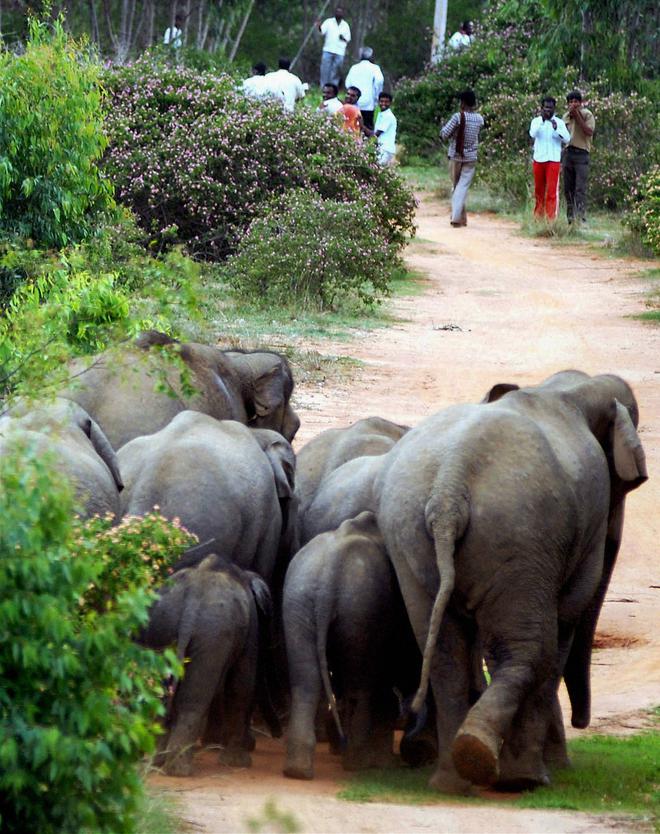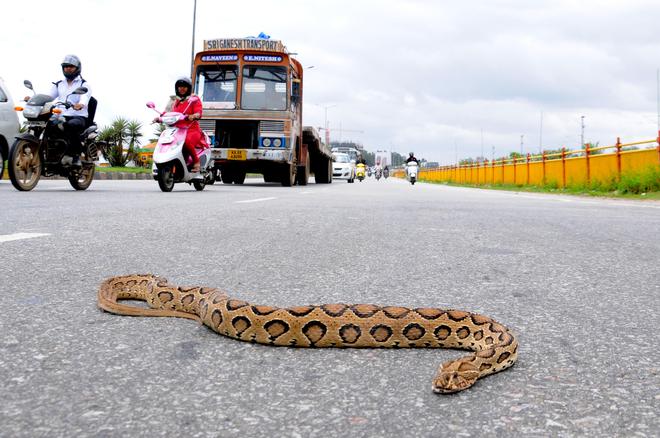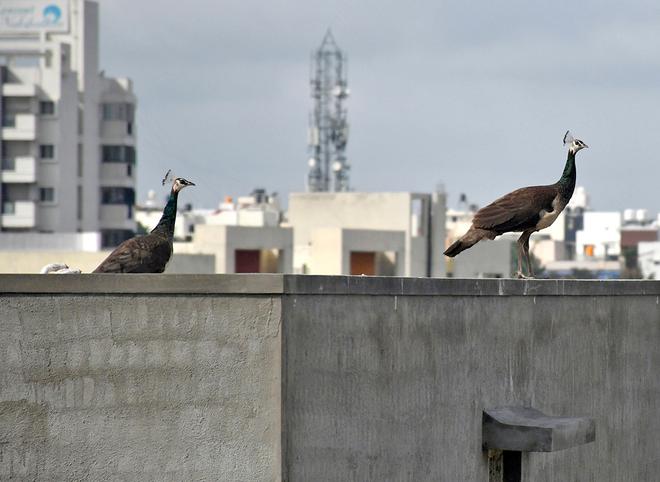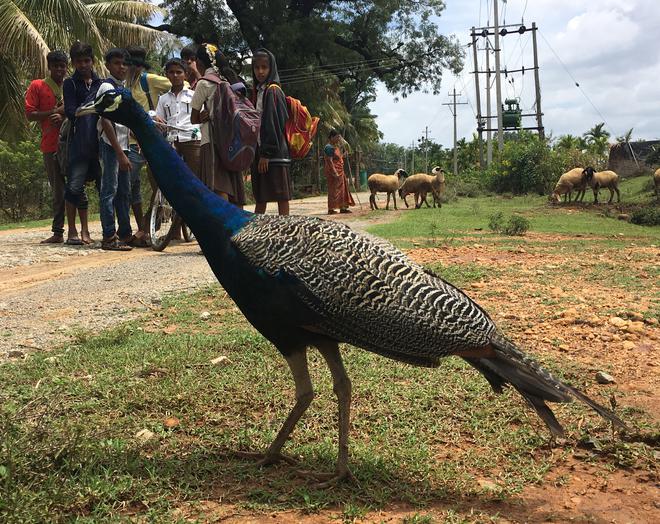It is common to hear about elephants, wild boars, peacocks, monkeys, and spotted deer destroying agricultural crops in villages near reserved forests. Now, this conflict has set foot in Bengaluru, India’s IT city. Wildlife experts here receive more than 100 calls every day seeking help to rescue snakes, macaques, owls, and fruit bats, and to remove hornets’ nests and bee hives. As the city rapidly expands, eating into animal habitats, leopards are the latest addition to the urban landscape.
Last month, three leopards were sighted in Bengaluru, one of which was shot dead. Activists say the frequency of sightings may increase, and people must learn to co-exist.
Fear in Kudlu
After a leopard was sighted and killed near Kudlu Gate in Singasandra, a sense of fear gripped residents in the vicinity. When a video of a big cat captured on a surveillance camera started doing the rounds, people stopped walking in the morning and evening hours. Shopkeepers were pulling down shutters at 8 p.m. People who used to take the road that the leopard crossed chose to ride or drive through the next street. Although there was relief after the animal was shot dead by Forest Department officials, many continue to exercise caution.
Pushpa K.S., who runs a medical shop, said, “People are now scared to venture out in the night thinking that another leopard might be lurking behind the bushes to hunt for stray dogs. There are many stray dogs here, which are easy prey for big cats.” Pushpa said senior citizens recall how the area was a forest before it was developed. Wildlife has been pushed further into Bannerghatta or into forest patches inside defence land.

Leopards were also sighted at Nelamangala and NICE Road. According to a forest official, the department has been receiving phone calls from Nelamangala about sightings, and cages have been placed to rescue the wild animal. “It also appears that the leopard population may have increased, but the department has no means to quantify this as no survey on leopards has been conducted in Bengaluru,” said the official.
Principal Chief Conservator of Forest Subhash K. Malkhede said that mere leopard sightings could be the basis for man-animal conflict. In NICE Road areas, leopards were sighted a decade back, and there was a board there that said it was a leopard crossing area.
“However, man-animal conflict is real, as development is consuming animal habitat. Earlier, on Bannerghatta Road, development went up to the Indian Institute of Management; and now it is up to Bannerghatta town. Bannerghatta National Park is located about 23 km from the Central Business District. The villages in Bannerghatta have been facing man-animal conflict,” he said.
Man-animal contact in the city
Almost every day, there is contact with wildlife in the city, and snakes top the list. There are about three wildlife rescue centres in Bengaluru and a forest cell in the Bruhat Bengaluru Mahanagara Palike. Every day, more than 100 calls are received. Unlike people in villages, the urban population has not learnt to co-exist with animals and they want them to be taken away from their neighbourhood, say experts.
Sharath Babu, a wildlife activist and rescuer, said, “If someone sees a snake crawling near their house, they make a call for rescue. Unless snakes enter the homes, there is no necessity for calling, as it is natural for them to move around.” Babu further said people in large apartments complain about beehives and hornets’ nests as they do not want them in their buildings. “Urban people who claim to be highly educated do not know how important bees are for the survival of human beings,” he said.

Monkeys have also been a common fixture in the city. Bonnet macaques pick up bananas and other food items if they are kept within reach. Apart from that, they are harmless. The macaques have been living in the city for centuries. The rescuers get at least 15 calls every day to take monkeys away. After rescuing monkeys, they are released in a forest area in the same forest division.
People also want owls and fruit bats to be kept away from their neighbourhood. Many believe that these are bad omens. Fruit bats lay nests in homes, and this is not unusual. Another rescuer who did not wish to be named said in villages bats fly inside the house, and people do not bother. “This is called coexisting. These bats are harmless. But in the city, at least five or six calls are received daily,” he added.
Villages lessons
Apart from chasing away elephants, wild boar, and deer into the forest, for destroying crops, the residents of villages near the Bannerghatta and Muthathi forest range have learnt to live with animals. Tajmahal, a resident of Bootanahalli near Bannerghatta forest, said he regularly sees elephants after dark near his colony. The pachyderms come in herds to eat grass or drink water. “After eating, they leave. The forest department has built solar-powered electric fences, but elephants trample upon them and come out,” he said. Bannerghatta-Sathnur-Savandurga is an elephant corridor.

Tajmahal alleged that these villages have become the city’s backyard to ‘dump’ macaques and stray dogs, although it is illegal to do so. “The dogs often become prey for leopards. The leopards have developed a taste for the stays as they are easy to hunt,” he said.
Kadrappa M., a forest official, said he and his team visit villages every day to chase elephants back into the forest from agricultural lands. “With loud sounds, like from crackers, we shoo them away to protect the crops. But in the dark hours, deer and elephants eat paddy and ragi crops, inflicting losses on the farmers. Farmers are also aware that they have no option but to live with them,” he said.
Mari Gowda from Karalekatte village near Muthathi forest range, which is located about 80 km from Bengaluru, said people from Ramanagara and Bengaluru bring macaques to Muthathi. These macaques have now become a menace in the villages as they eat coconut and banana.”
On the other hand, the people who visit here feed them, changing their natural behaviour. Some monkeys have forgotten how to find food inside the forest. “Scenes of bonnet macaques standing near the road staring at humans to feed them are very common here,” he said.

Leopard sighting: Precautionary steps
* Mere sighting does not translate into danger
* They are sensitive enough to avoid contact with people
* Be alert, especially after dark (when leopards are primarily active)
* Ensure that children are accompanied by an adult, if they are outdoors
* Play music on the phone to alert leopards of human presence
* Ensure that your area is well-lit
* If a leopard is sighted, do not crowd around; allow it to move away
* Aggressive posturing may cause it to react in panic
* Ensure effective garbage disposal and removal of feral dogs. If your colony has a dog, you could ensure that it is kept indoors or in a kennel away from the building. While dogs alert us, their barks are known to attract leopards







